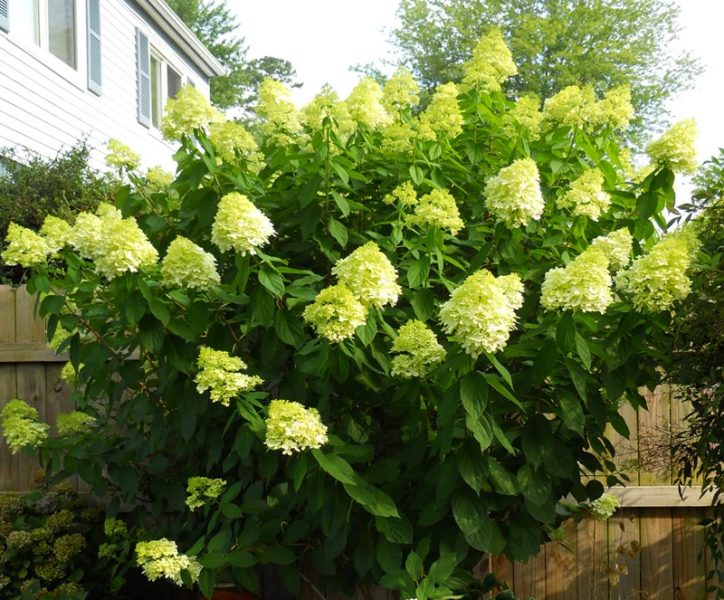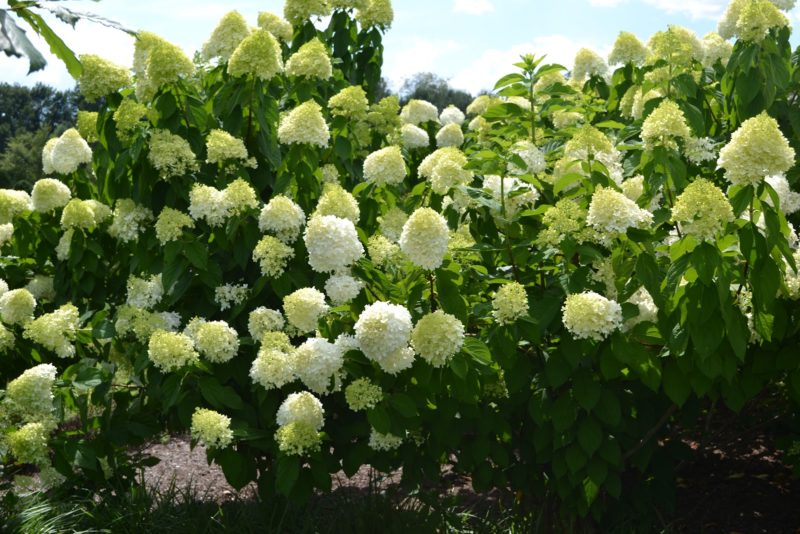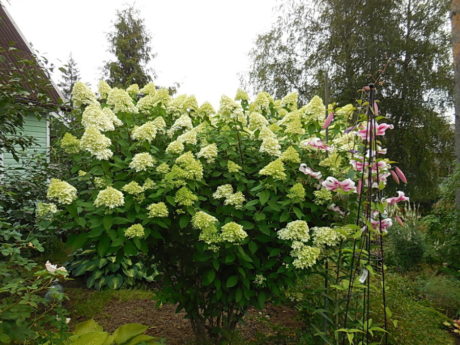Hydrangea Limelight is a spectacular decorative and deciduous shrub. Due to its high and durable shoots with large flowers, it has gained high popularity both among Russian and foreign flower growers.
Material Content:
Panicle Hydrangea Limelight - description

Limelight hydrangea can be described as follows:
- Height 1.5 meters or more.
- Crohn spreading form.
- Egg-shaped leaf plates of saturated green color.
- Brown shoots with exfoliating bark.
The flowering period of this hydrangea lasts from mid-summer to the second half of September. With good care, this variety is characterized by very abundant flowering.
Limelight inflorescences can be described as follows:
- Length 25-30 cm.
- Pyramidal shape.
- In the phase of dissolution of lemon-green.
- In the autumn with a pink tint.
Among the advantages of the variety, it is worth noting strong shoots that easily hold large caps of flowers, which is not characteristic of other panicled varieties.
Planting panicled hydrangea in open ground
The place for planting hydrangea Limelight should be chosen sunny or, in extreme cases, a little shaded. This culture prefers soils loose, with good indicators of air and moisture permeability. They should also be quite fertile, high in humus.
How and when to plant?
The best time for planting panicle hydrangea is considered spring. If you immediately want to admire the flowering, then for planting you should buy a 2-3 year old seedling. Younger plants will bloom only after a year or a half.
Planting hydrangea limelight as follows:
- A pit 50 × 50 cm in size is laid with a depth of about 30-35 cm. More accurate dimensions depend on the size of the seedling.
- The roots of a seedling are pruned.
- All shoots are shortened to 2/3 of the length. The main thing is that at least 2-3 pairs of viable kidneys remain on each of them.
- The seedling is placed in a pit, while ensuring that its root neck is at the level of the soil surface.
- The trunk circle after planting is watered abundantly.
- The soil surface under the bush is abundantly mulched with a 6-8 centimeter layer of peat.
In regions with warm winters, hydrangea bushes can be planned for the fall. The procedure is the same.
Limelight Hydrangea Care
Panicled hydrangea does not require very complicated care. The main thing is to follow the agrotechnical measures described below.
Watering and feeding
Regular and abundant watering of hydrangea bushes contributes to the development of the largest possible inflorescences. With a lack of moisture, plants form small and ugly buds.
Also, timely top dressing is very important for this culture. The first time hydrangea is fed in the early spring, immediately after the snow melts. For this, urea is used. A solution is prepared from it at the rate of 15-20 grams per bucket of water. One adult bush will need at least 2-3 buckets of fertilizer.

Urea top dressing in early spring contributes to better shoot growth after a period of winter dormancy. Later, before the budding phase, hydrangea is fed again. To do this, use complete mineral complexes. They should be bred according to the attached annotation.
Pruning
Hydrangea care must include pruning. Carry out it in two terms: in spring and autumn.
Autumn pruning
During this period, all drying inflorescences are cut out on the bushes, thereby freeing the plants from excessive load.
Spring pruning
The main purpose of spring pruning is the formation of full-fledged bushes. It should be started as soon as possible, while it is necessary to catch it before the swelling of the kidneys. First of all, all shoots frozen in winter are cut to a healthy place. Then, last year's branches are shortened to 4-5 buds. And last of all, they start the rarefaction of the crown. To do this, cut out all the shoots growing inside the bush.
In the spring, anti-aging pruning of old plants is also carried out. To do this, they simply cut off "on a stump." Limelight blooms on the shoots of the current year, so flowers on it will appear the same summer.
Separately, it is worth mentioning about pruning inflorescences from young hydrangeas. In most cases, such specimens bloom for 2 years after planting. By this time, the bushes still do not have time to grow enough, and discarded inflorescences only hinder their development. Therefore, for 2 years they should be plucked even in the budding phase.
How to care for hydrangea in autumn, winter
Adult, well-developed hydrangea bushes winter well without any shelter. Even with the freezing of their shoots, flowering occurs in the same summer.
Annual bushes for reinsurance should still be covered. To do this, use a non-woven covering material such as Spunbond. They just wrap the bushes in several layers.
Breeding
Panicled hydrangea of this variety is excellently propagated by cuttings. In this case, you can use both lignified and green cuttings. Lignified cuttings are cut in the spring at the time of kidney swelling. Their harvesting can be combined with spring pruning.

Each stalk must have at least 2 nodes. Moreover, the lower cut is done directly under the lower kidney, it is performed obliquely. The upper section is straight, it runs slightly above the upper kidney.
Hydrangea cuttings prepared in this way are planted in a small greenhouse from a plastic 5 liter bottle. For ease of use, its top is cut off only on three sides. The result is an improvised lid that effectively retains moisture.
The soil for planting should be loose and sufficiently fertile. For example, you can use a mixture of river sand and peat in a ratio of 1: 1. If there is no possibility for self-preparation of the soil mixture for planting, you can use the soil for growing seedlings.
Planting of cuttings is carried out to a depth of not more than 3 cm, while the lower kidney is necessarily buried in the soil. After planting is completed, the soil is abundantly watered with warm, settled water. For greater effectiveness, a root stimulant can be added to the water. For example, Kornevin powder is suitable for these purposes. The technique of its use can be found directly on the packaging.
Under the conditions, after about a month, leaves begin to develop on the cuttings. A month later, they can already be planted in open ground. Plants grown in this way bloom for 2-3 years from the time of planting.
Protection against diseases and pests
Hydrangea diseases are extremely rare. But pests in some years can annoy her very much. Especially often on it there is a spider mite and aphids.
Spider mite
A spider mite is a common sucking pest. A sign of its appearance is a characteristic sticky cobweb-shaped raid. In the absence of appropriate treatments, this pest is capable of very severe damage to the bushes. To combat it, special acaricidal agents are used. The use of ordinary insecticides against it is ineffective.

For the treatment of hydrangea against the spider mite, you can use Actellik or Fitoverm. Bred them according to the attached instructions. Processing must be carried out in dry, calm weather. After 10 days, the spraying is repeated.
Aphid
Aphids are a widespread sucking pest. Depending on the species, it may be green or black. Fighting her is very easy. With a small number of pests, just one treatment with a solution of laundry soap will be enough.
If the aphid population is large enough, use spraying with an insecticide solution. For example, you can use "Alatar", "Commander" and the like.
Use in landscape design
Hydrangea Limelight is great for creating single compositions as well as for group plantings. At the beginning of its growing season, it is still not very decorative, therefore, it is recommended to plant spring-blooming bulbous plants: tulips, daffodils, hyacinths.
In addition, it goes well with a number of other perennial plants: peonies, irises and lilies. Flowering limelight hydrangea bushes effectively decorate unsightly fences and walls of buildings. They will also be an excellent background for almost any flower garden.















